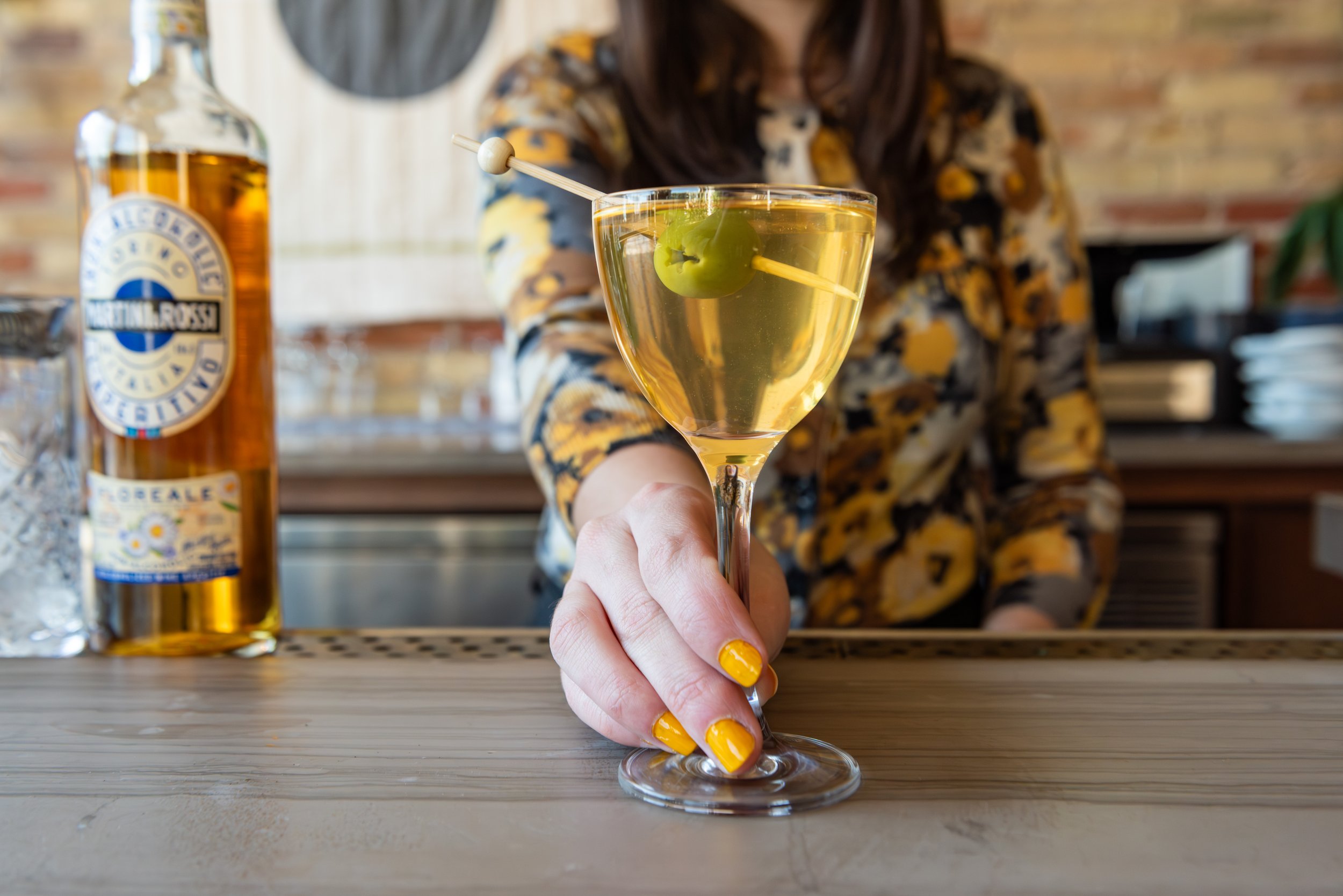Verjus in Lieu
Unripe grape juice is a versatile substitute for chefs and bartenders alike.
Seedlip Garden Aperitivo, Thyme Verjus, Martini & Rossi Floreale Non-Alcoholic Vermouth, Chamomile Syrup, Olive Brine AT ELSKE
In the Middle Ages, verjus—unripened, unfermented grape juice—was a mainstay ingredient in cooking before it was gradually replaced by lemons in Western European and Middle Eastern cuisine. Since then, the popularity of verjus has waned, but in recent years, the product has found its place as a strong, inconspicuous substitute for acid, vinegar products, and even wine in kitchens across the country.
To produce verjus, winemakers harvest a handful of unripe grapes at the moment of veraison—when the fruit turns from hard and dull to soft and plump. Then, they press out the juice before bottling it a few days later. The quick turnover prevents fermentation and allows the juice to hold on to its fresh, tart, and sweet notes. For the winemakers, there is another benefit. The remaining grapes on the vine draw nutrients more efficiently, now that they aren’t competing with a larger pool of individual crops, giving the wine-destined grapes an agricultural boost.
Thanks to its brightness, general balance, and ability to play second fiddle in terms of flavor, verjus has never gone completely out of fashion, even as citrus and other acid-heavy products shine in the spotlight. In Chicago, though, chefs aren’t the only ones championing the ingredient. Bartenders and brewers are working with the unfermented grape product as a way to round out their cocktails and develop more complex non-alcoholic options for guests.
Bartender Monica Casillas-Rios of Elske relies on verjus as a way to subtly introduce juicy citrus and white wine flavors to her menu. “It just gives more depth to the cocktail,” says Casillas-Rios, and has “a gentle balance of sweetness and acidity.” In her N/A riff on the dirty martini, she translates classic briney flavors into a sour-like build. It consists of Martini & Rossi Floreale, Seedlip Garden 108, chamomile syrup, and olive brine, as well as blanc verjus which acts as a conduit for acid in the drink. “It's nice to have something else to play with outside of things like juice,” she says. Plus, “it gets rid of the kind of waste that sometimes comes with fruit.”
Pet Not: Carbonated Verjus, Pear Juice, Grape Skins, Vanilla, Blue Poppy Seed, Dandelion Root at Daisies
Hibiscus Spritz at Jun Bug Kombucha
With several brands now available in the United States, there is greater variety in the kinds of traits chefs and bartenders can pull out of verjus. While some are still better for culinary applications, bartenders like Nicole Yarovinsky are appreciating verjus for its “body” and finding ways to incorporate even more dynamic flavors into the juice. “I would rather infuse verjus because of its textural components. It has this base quality of balance and complexity that I like to modify slightly to taste a little more adult and a little more intriguing,” she says. Wanting to provide a non-alcoholic sparkling wine alternative that was still interesting and satisfying to guests, Yarovinsky set her sights on verjus. For the Pet N/Ah at Daisies, she combines two different verjus with ripe, fresh-squeezed grapes and their skins. The mixture is cooked sous vide with herbs, spices, and fruits, which change depending on the season and what scraps are leftover from the kitchen. She also adds a touch of toasted yeast to provide “that brioche quality without putting bread into the mix.” For service, the infused verjus is force carbonated. The juice holds on to those warm spices, helps express the sweet notes of the fruit, and keeps “that tartaric acid quality that you don't get as strongly from many fortified wines,” says Yarovinsky. “We can use powdered citrus—and vermouth and Sherry and wines—but at the end of the day, you want that juicy acid.”
Some verjus even have “minerality that mimics white wines,” says Brewer Sam Fazioli of Jun Bug Kombucha. His hibiscus kombucha spritz plays on verjus' wine-like body, but initially the idea was to create a bittersweet mocktail in the vein of a negroni or Aperol spritz. Fazioli knew he needed gentian root “to mimic the Campari and Aperol,” but he also needed something to evoke the sparkling wine and vermouth components of those cocktails. To bring out those characteristics, he infuses verjus with gentian root, orange peel, and hibiscus, which provides the kombucha with a deep orange-red color as well as a tart, sweet, and refreshing flavor. The addition of the verjus helps the kombucha “stay on the brighter end of things and the bitter side.”
As non-alcoholic cocktails and beverages continue to gain momentum across the country, verjus is proving itself to be a versatile ingredient for bartenders (and brewers). Whether as a supporting character or the base for bolder flavors, “verjus is an incredible ingredient,” says Fazioli, but it’s about “getting it out there, [showing] that it's not just a chef-y ingredient or for a fancy cocktail bar.”






